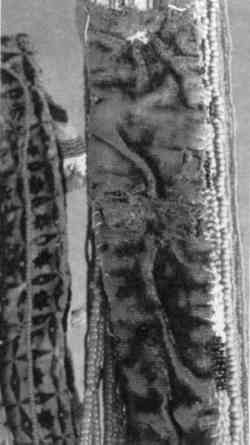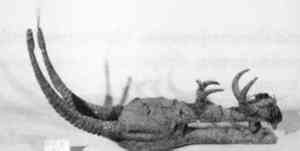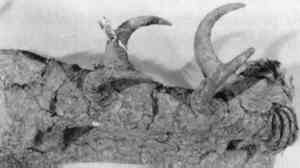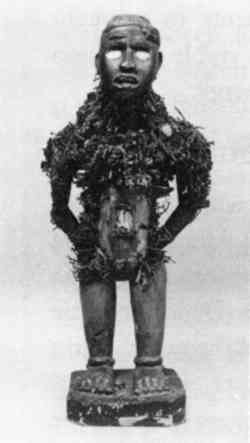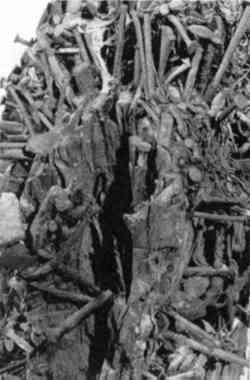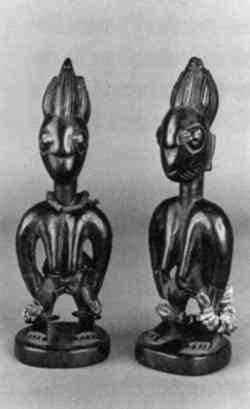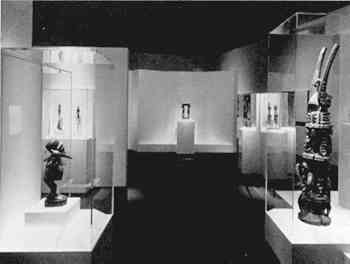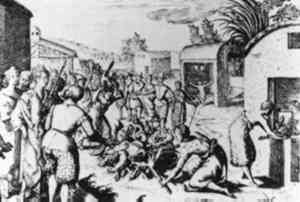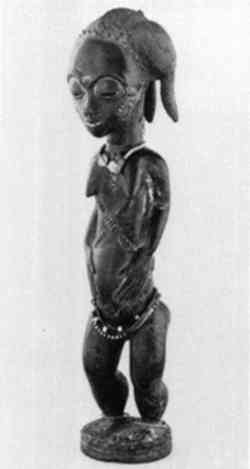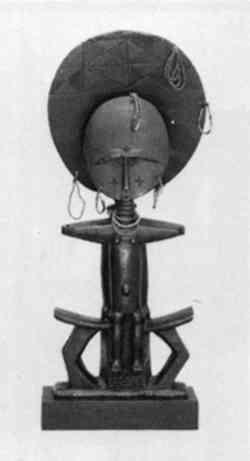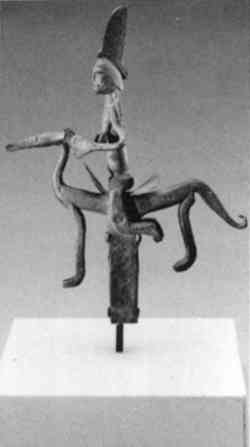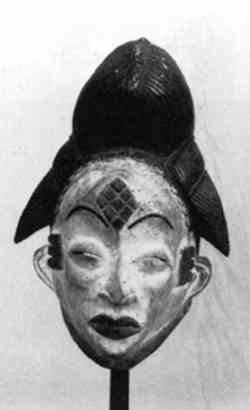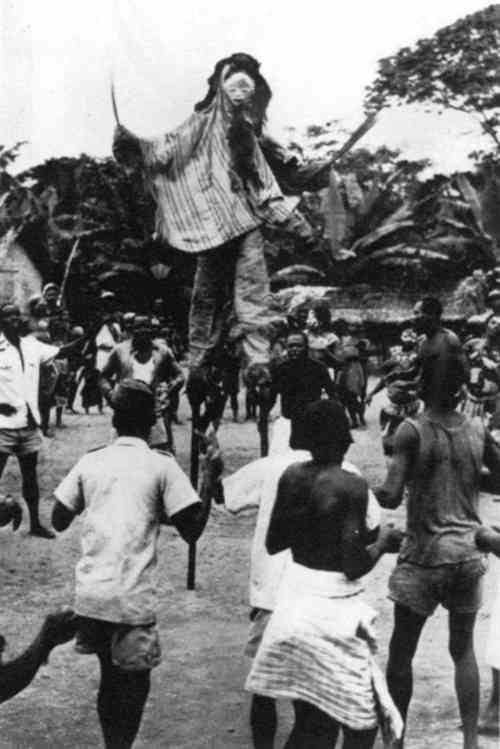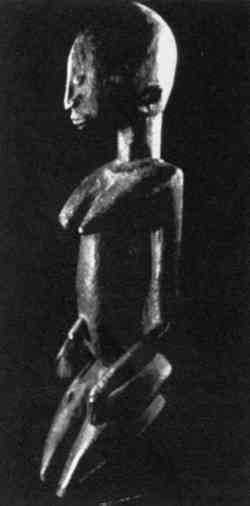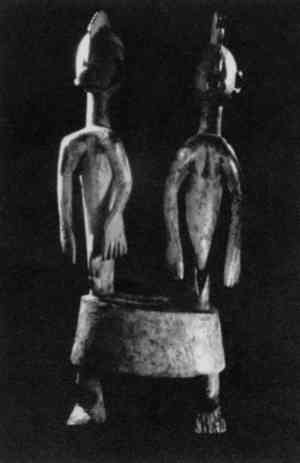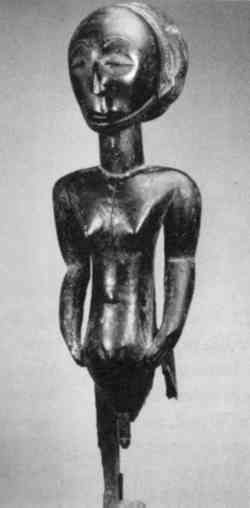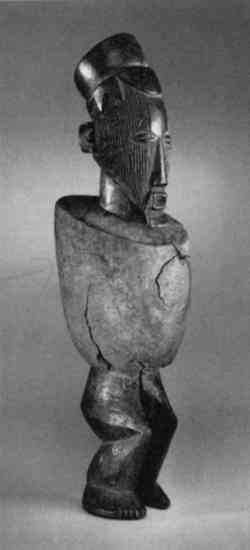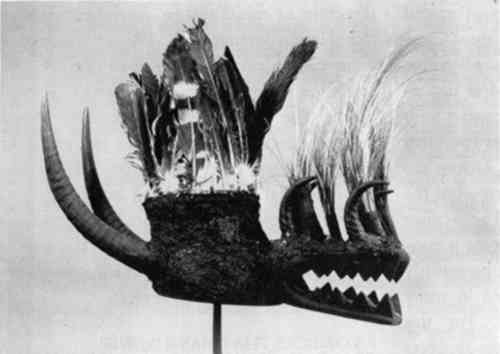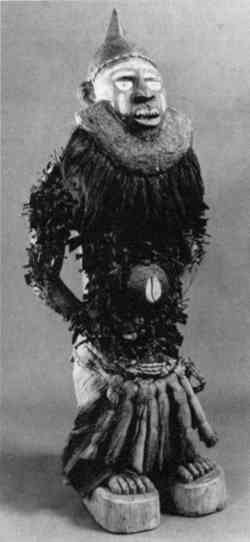THE EXHIBITION AND CONSERVATION OF AFRICAN OBJECTS: CONSIDERING THE NONTANGIBLESTEPHEN P. MELLOR
ABSTRACT—This paper examines the use, function, and maintenance of particular objects with nontangible significance in some African cultures. Deductive observations about these objects allow possible conclusions to be drawn regarding: (1) an African perception of magic, sacred, and power; and (2) an African perception of culturally significant objects in and out of an indigenous context. The suggestion is stressed that it is the responsibility of the conservator to remain informed about an object's nontangible attributes and to treat African objects with cultural dignity. 1 INTRODUCTIONMany people in Western cultures view African objects as culturally foreign and aesthetically challenging while readily acknowledging their nontangible attributes. Yet these nontangible attributes are often poorly defined and considered not only incomprehensible but also potentially dangerous. These attributes might include the concepts that objects embody supernatural spirits, personify ancestors, or maintain power inherently. As conservators, we work intimately on these objects; we understand the physical and chemical properties of these sometimes complex constructions, but their nontangible aspects can still remain difficult curiosities that are partially addressed through courteous but uninformed acknowledgment, benign disregard, or even outright fear. This paper is an attempt to look at these nontangible attributes associated with African objects and how these attributes affect treatment decisions that we make in a nonindigenous setting, that is, in art conservation laboratories, studios, or exhibition planning meetings. Some specific examples in African art where nontangible attributes might have an effect on treatment decisions can be seen in the following:
Africa is two and one-half times the size of the United States, contains 44 sub-Saharan countries, and thousands of linguistic and traditional cultural groups. These factors—coupled with Africa's distance from the United States and its relative geographic inaccessibility, as well as the impact of culture change over time due to politics, religion, or colonialization—make access to the people who can best interpret an object's nontangible attributes difficult. In addition, Africa lacks transcontinental advocacy groups who might actively address material culture issues. It is the intention in this paper to ascertain an indigenous perspective: how Africans feel about nontangible attributes, how Africans might view objects out of their cultural context, and how Africans might want us to treat their culturally significant objects. 2 THE AFRICAN VIEW OF NONTANGIBLE ATTRIBUTESWithout access to the people who made and used these objects, the best approach is to look at the use, function, and maintenance of objects in their cultural setting in an attempt to extrapolate how Africans feel. The method of inquiry included an examination of the life histories of some objects in the Permanent Galleries at the National Museum of African Art (NMAfA), Smithsonian Institution, Washington, D.C., as well as works in other collections with particular nontangible significance. Curators, art historians, anthropologists, and Africans in the museum field who had contact with African cultures and could provide cultural insight were surveyed. Curators are often our first source of information pertaining to collection objects. Their knowledge regarding manufacture, use, and collection history consistently refines a conservator's observations and treatment proposals. However, the responses from curators when asked about nontangible aspects often seemed vague and ambiguous. One curator said, for example, that it was acceptable for anyone to view the interior of the Yoruba crown on exhibition at NMAfA provided there were no Nigerians present. Other comments bordered on the pejorative, as in “I don't believe in ju-ju”—a reference to African religion. From the literature, we can see that as early as the 16th century, the nontangible attributes of African materials were being addressed. The text associated with a 1598 German engraving, titled Abjuration du Roi de Congo(fig. 10), argues that the forces emanating from some African objects were so disturbing that it was necessary to burn them (MacGaffey 1990b). During the 19th century, when African objects increasingly entered Western cultural institutions, they were seen as curiosities and aberrations that did not fit within the realm of organized Western religions. Even today, some museum personnel admit to being slightly uncomfortable in African art storage and consciously avoid those areas.
Of course, in reality, complex cosmological and religious systems exist throughout Africa. Simply stated, these systems exist to manipulate an invisible world that can directly affect the day-to-day existence of a cultural group. In turn, they reinforce interpersonal interactions as well as political and economic systems. In the literature, the terms “magic,” “sacred,” and “power” are often used randomly and interchangeably in reference to African material culture. To more clearly distinguish individual objects, distinctions among these categories are offered here. It should be presumed that in a cultural context there is less distinction between “magic,” “sacred,” and “power”; consequently, techniques for using these nontangible concepts 2.1 OBJECTS THAT ARE MAGIC“Magic” is the most ubiquitous and also the most difficult concept to define. Magic transpires when supernatural forces are invoked to produce otherwise unexplainable, often individualized results. The use of magic can be the domain of ritual specialists such as diviners, oracles, and witches as well as craftsmen who control the magic inherent in some raw materials. A Chokwe divination basket (fig. 11) contains more than 100 reference symbols, such as small figures, miniature tools, or bundles of plant and animal parts, that to the uninformed individual appear to become randomly configured when the basket is shaken. A diviner, however, can interpret these magic configurations. The diviner's abilities come from two possible sources: He or she may have been trained by supernatural forces, or may be actually spirit possessed during the consultation. These abilities allow the diviner to act on behalf of the supernatural world to advise a client or solve a problem.
Interestingly, a diviner's prescription can result in the commissioning of a work of art such as a Baule female figure (fig. 12)(Anderson and Kreamer 1989). The physical characteristics of the sculpture would be rigorously specified by the diviner. The Baule believe some spirits to be particularly hideous, with feet that point backwards, filthy skin, and wild red hair (Vogel 1973). In the case of this type of figure, it was the intention of the artist to create a sculpture that attains the highest cultural aesthetics, thereby placating a displeased or trouble-causing spirit. The commissioning and creation of the sculpture, rather than the actual existence of the sculpture, magically intercede for the benefit of a client.
Similarly, a unique Akan double-headed akua'ba(fig. 13) was commissioned as a vehicle for supernatural forces to induce pregnancy. The akua'ba is carried by a woman for a specific period of time, adorned with beads, and suckled and treated as a real child, thus ensuring conception and healthy delivery. After effecting pregnancy, at which time it has fulfilled its function, the akua'ba can be relegated to a shrine as an advertisement for the success of supernatural intervention, or it might be sold, given away, or treated as any other secular object.
Throughout Africa, blacksmiths retain a high social standing because they control the inherently magic raw material—iron. Among the Bamana, skill in smithing is seen as a mastery over the magic in nature and results in a concentration of cultural energy (nyama) in the blacksmith himself. This nyama affords the blacksmith tremendous authority, and his creations, from farming implements to wrought sculptural forms (fig. 14), are a visible expression of this accumulated cultural energy.
2.2 OBJECTS THAT ARE SACREDSacred objects function within the more structured realm of traditional African religions and constitute the largest category of African material culture. Most African religions contain a broad and hierarchical pantheon of spirits often referred to as bush, water, and ancestral spirits. Within a community, these spirits can be reached through elaborate masquerades, within shrines or during annual ceremonies. It is understood in Western cultures that masks such as a Kalabari water spirit mask or a Punu bush spirit mask (fig. 15) are only one component of a masquerading ceremony that includes an associated costume, dancing, music, and other ritual behavior (fig. 16). It is not well
Shrines are found throughout Africa and vary widely in purpose, place, and form. A Dogon shrine figure (fig. 17) comes closest to typifying Western expectations of the appearance and use of shrine sculpture. The figure would have been placed on a personal altar and, amid incantations, water and rice gruel would have been poured on it and probably several animals would have been sacrificed. For the Dogon people the sculpture serves several purposes. It identifies the individual who is asking for supernatural intervention, being made in his or her image and not that of a spirit. Moreover, the sculpture draws the attention of the supernatural beings to the proceeding, because the Dogon believe that these beings are inherently lethargic and have limited attention spans. Most important, the figure maintains constant contact with the supernatural world until its owner's problem is resolved. It is reported that the Dogon say “one cannot always kneel at the altar—but the statue can” (Van Beek 1988, 60). The sacrifice is pivotal, and without it the sculpture is considered simply a piece of wood. A particularly successful statue that has been used in many sacrifices can become dangerous. For this reason, less frequent and less elaborate sacrifices deactivate the figure, and it can then be safely discarded.
The significance of sacred Chamba figures (fig. 18) is not in the individual sculptures themselves but in their placement and association with other figures that identify a sacred grove in the Benue River valley region of northern Nigeria. The grove is maintained as a dwelling place for spirits and provides an important way station in the transition of souls to the afterlife. It is reported that if the figures are removed, the grove and indeed the Chamba people will wither and die (Stevens 1976). However, religious protocol indicates that it is imperative that these sacred figures be minimally sheltered and exposed to the elements over which the spirits exercise control. Consequently, the periodic replacement of insect damaged or weathered figures is a prerequisite in their cultural care. In this situation, a new figure not only replaces the old figure but actually becomes the old figure. Continuity of the sacred is maintained, and the old figure can be retired.
Ancestor worship is thought to be an integral part of many non-Western religions. In many African religions the deceased are regarded as having certain control over their descendants. They can influence childbirth, effect cures, or ensure success. Ancestor sculptures like Hemba figures (fig. 19) are created as memorials to commemorate the deceased. The sculptures act as a visual reminder of ancestral power. The effectiveness of each object, however, is directly proportional to the extent of living memory. After only a few generations, the individual commemorated by this type of sculpture would not specifically be remembered, and the sculpture would fall into a generic ancestral category in which it is less accurately identified and less revered.
2.3 OBJECTS THAT HAVE POWERThe third category of African objects with nontangible attributes deals with power. These objects, simply by their constitution, maintain intrinsic power. Within their cultures, these objects are distinguished by the fact that they have a will of their own, can independently carry out The materials incorporated into these objects impart power. Nonvisible elements known to be included in the construction of these objects include riverbed stones from the dwelling places of water spirits; certain red and white earths; medicinal plant substances with bush spirit power; bones, flesh, fur, or claws of a lion, leopard, or monkey; droppings of lightning found at the base of trees; bones and flesh of someone who committed suicide; fingernails and hair of sorcerers; or bits of warrior remains from a battleground. Visible embellishments can include animal horns, reptile skins, feathers, textiles, nails, beads, metal, fur, shell (Hersak 1986), and all of those materials familiar to ethnographic conservators. The accumulated energy from these significant elements is realized when included in an object. The inclusion and association of elements are never random but follow strict cultural guidelines and traditions drawing upon the powers of ancestors, diviners, and spirits. As with magic and sacred objects in Africa, sacrifices, libations, ceremonies, and rituals, performed by a specialist, are required to invoke the power of power objects. However, it is the accumulation of additive elements over time and the buildup of sacrificial patination on these objects that continue to enhance their effectiveness. Power substances in a Teke figure (fig. 20) are concealed in a cavity in the chest. After elaborate rituals, including anointing the figure with clays or imported camwood, tree sap, or blood and spit, the figure is considered to have been given birth and is invested with power. The power can be effective for economic success in hunting and trading or useful against disease. Although the effectiveness of the figure's power is not always consistent, the Teke seldom consider the figure to be without power (Hottot 1956). When ineffective, the figure's health and therefore its power can be restored through rituals that vary from exposing it to soothing music to beating it with a switch. Only in rare instances can a figure lose its power; sorcery or spiritual intervention invoked by another person directly against the figure can render it totally powerless.
A Songye figure (fig. 21) derives its power from accumulated substances. It would have been maintained in a shrine with limited access. The purpose of limited access is twofold: to protect the community from the effects of overexposure to its power and, to protect the object from extraneous contamination that could severely diminish its power and effectiveness. Should either event occur, the figure would be replaced with a fresher, newer, more powerful construction.
The thickness of the incrustation (McNaughton 1978), as well as the combination of additive elements, on one type of Bamana Komo mask (fig. 22) indicates the mask's degree of intrinsic power. The Komo mask is under the strict domain of Bamana blacksmiths, who are responsible for maintaining a harmonious equilibrium throughout Bamana life. Through its construction and association with blacksmiths, the Komo mask harnesses great quantities of cultural power. In the event that the blacksmith is not judicious in his use of authority for the good of the community, it is likely that he would be challenged, thereby significantly diminishing his power and that of the Komo mask.
The Kongo people do not readily distinguish among human beings, animals, and objects as containers for power. After fabrication and
Despite the extraordinary power of nkisi figures, one of the most effective ways the Kongo people have to render them powerless is simply to treat them with indifference, that is, to ignore the behavioral restrictions required toward them or neglect their cultural status. The power of a nkisi can also be mitigated if it is deliberately destroyed, if its owner dies, or if it is sold or transferred (MacGaffey 1990a). In all these situations, however, there is the possibility that the nkisi will retaliate. 3 OBSERVATIONS AND CONCLUSIONSFrom this brief look at how some African objects function in cultural context, several observations can be made. In some African societies, objects are used as intermediaries, they mediate, placate, provide access to, respond to, or focus the attention of the supernatural world. Specialized individuals and highly structured behavior or activities are required to make effective use of the nontangible attributes of these objects. Unexpectedly, it is observed that although objects can be passed on for generations, even magic, sacred, and powerful objects are routinely and systematically inactivated, replaced, discarded, ignored, or destroyed within their cultural context. From these observations, several deductions that may be applicable to other African cultures can be made that begin to illuminate an African perspective about the existence, use, and maintenance of nontangible attributes:
Conclusions can be drawn that might express an African perception of objects exhibiting nontangible attributes and reflect an African perception of these objects outside of their cultural context:
4 IMPLICATIONS FOR CONSERVATORSThese conclusions presenting a possible African view of indigenous material culture have important implications for conservators because they begin to broaden our understanding of the African objects we are responsible for and refine our treatment and exhibition care decisions. Most important, it becomes clear that, as conservators, it is not necessary for conservators to treat African objects that are out of their cultural context with the same strict behavior required when they are within their cultural context; nor would Africans expect them to receive that kind of treatment. We need not feed these objects, wash them, dance them, suckle them, spit on them, beat them, insult them, sacrifice upon them, or subject them to limited visibility. Indeed, it is somewhat patronizing to presume that we could replicate these complex patterns of cultural behavior toward objects. Furthermore, we need not approach African objects with uncertainty, fear, or trepidation. Standard conservation decisions that might be relevant to African objects include, for example, the method and degree to bulk gap filling materials to provide structural stability to a wooden object; the choice of synthetic resin and technique of application to consolidate applied incrustation; or the extent of filling and inpainting to provide visual integration to a painted surface. For example, the shattered arm on the nkisi in figure 5 was re-adhered and stabilized with Dow Corning RTV 3110 silicon rubber that was bulked with Union Carbide phenolic microballoons, BJO-0930. The acknowledgment and understanding of the nontangible attributes of African objects may not have a dramatic effect on conservation treatments, but at least they should affect the way conservators think about African art. These conservation decisions should be overshadowed by the conservator's responsibility to treat or participate in the installation of African objects in a manner that conscientiously respects the dignity of the cultures that produced them. The interpretation of an object and its presentation for exhibition with dignity can be a difficult and subjective issue. The National Museum of African Art is in the initial planning stages of an exhibition of Kongo minkisi (plural of nkisi) and works by contemporary African artists who draw directly on the minkisi tradition. The artistic intention of the contemporary artists may preclude the use of vitrines to protect their constructions; however, conservation sensibility of lending and host institutions would undoubtedly require the vitrining of the fragile minkisi figures. This contradiction between the exhibition of objects borne of the same tradition must be resolved by the institution. One might ask, as well, if it is appropriate to vitrine objects of such unmitigated power. The conservation problems associated with leaving such complicated 5 CONCLUSIONTo care for African objects in a manner that respects their aesthetic, formal, contextual, and nontangible attributes, conservators must remain vigilantly informed about African cultures. This can be a formidable task, particularly when we are confronted with objects for which the historical and contextual records are incomplete. However, by pursuing dialogues with Africanists, anthropologists, art historians, and Africans and by studying pertinent literature from dissertation studies to catalogues raisonn�s, conservators can constantly refine their understanding of African objects. When conservators are prepared to make informed conservation decisions concerning treatment and exhibition and offer enlightened opinions regarding acquisitions, deaccessioning, or even repatriation, then they will be assured that they have treated these objects with dignity. REFERENCESAnderson, M., and C. M.Kreamer. 1989. Wild spirits strong medicine: African art and the wilderness. New York: Center for African Art. 58. Cole, H.1989. Icons: Ideals and power in the art of Africa. Washington, D.C.: Smithsonian Institution Press. Hersak, D.1986. Songye masks and figure sculpture. London: Ethnographica. 130. Hottot, R.1956(prepared for publication by Frank Willett). Teke fetishes. Royal Anthropological Institute of Great Britain and Ireland Journal. 86:25–36. MacGaffey, W.1990a. The personhood of ritual objects: Kongo minkisi. Etnofoor3(1):45–61. MacGaffey, W.1990b. Magic, or as we usually say, art. Unpublished paper. Haverford, PA. Haverford College. 4 McNaughton, P. R.1978. Bamana blacksmiths. African Arts12(2):65–71, 92. Rubin, A.1974. African accumulative sculpture: Power and display. New York: Pace Gallery. 14. Stevens, P.1976. The Danubi ancestral shrine. African Arts10(1):30–37, 98–99. Van Beek, W.E.A.1988. Function of sculpture in Dogon religion. African Arts21(4):58–65, 91. Vogel, S. M.1973. People of wood: Baule figure sculpture. Art Journal33(Fall):23–36. OTHER SOURCESArdouin, C. D.1990. The West African museum project: Brief introduction. West African Museums Project Bulletin no. 1. London: International African Institute. Barclay, R., M.Gilberg, J. C.McCawley, and T.Stone, eds.1987. Symposium 86: The care and preservation of ethnological materials. Ottawa: Canadian Conservation Institute. Brain, R.1988. Art and society in Africa. New York: Longman Group. Center for African Art. 1988. Art/artifact African art in anthropology collections. New York: Center for African Art. Cole, H., and D. H.Ross. 1977. The arts of Ghana. Los Angeles: UCLA Museum of Cultural History. Cole, H. M., and C. C.Aniakor. 1984. Igbo arts: Community and cosmos. Los Angeles: UCLA Museum of Cultural History. de Areia, M.L.R.1985. Les symboles divinatoires. Coimbra, Portugal: Centro de Estudos Africanos, Instituto de Anthropoligia, Universidade de Coimbra.
Ezra, K.1988. The art of the Dogon. New York: Metropolitan Museum of Art. Goldwater, R.1960. Bamana sculpture from the Westerm Sudan. New York: University Publishers. Greenfield, J.1989. The return of cultural treasures. Cambridge: Cambridge University Press. Huet, M.1978. The dance, art and ritual of Africa. New York: Pantheon Books. Lamp, F.1986. The art of the Baga: A preliminary inquiry. African Arts19(2):64–67. Lopez, D.1970. A report of the kingdom of Congo and of the surrounding countries. [1609] Reprint London: F. Cass. MacGaffey, W.1977. Fetishism revisited: Kongo nkisi in sociological perspective. Africa47(2):172–83. MacGaffey, W.1988. Complexity, astonishment and power: The visual vocabulary of Kongo minkisi. Journal of Southern African Studies14(2):188–203. Mbiti, J. S.1969. African religions and philosophy. New York: Praeger Publishers. Mbiti, J. S.1975. Introduction to African religion. New York: Praeger Publishers. McEvedy, C.1988. The Penguin atlas of African history. London: Penguin Group. McLeod, M., and J.Mack. 1985. Ethnic sculpture. London: British Museum Publications. McNaughton, P. R.1988. The Mande blacksmiths: Knowledge, power, and art in West Africa. Bloomington, Ind.: Indiana University Press. Mibach, L., and S. J.Wolfe. 1983. Ethical considerations in the conservation of Native American sacred objects. Journal of the American Institute for Conservation23:1–6. Northern, T.1984. Art of the Cameroon. Washington, D.C.: Smithsonian Institution Press. O'Donohue, J.1981. Spirits and magic: A critical look. Nairobi, Kenya: Gaba Publications. Objets interdits. 1989. Paris: Foundation Dapper. Olaniyan, R.1982. African history and culture. Essex, Eng.: Longman Group. Parrinder, G.1987. African mythology. New York: Peter Bedrick Books. Preston, G. N.1985. Sets, series and ensembles in African art. New York: Center for African Art. Raphael, T.1987. The repatriation and treatment of Native American objects. In Symposium 86: The care and preservation of ethnological materials, ed.R.Barclay, M.Gilberg, J. C.McCawley, and T.Stone. Ottawa: Canadian Conservation Institute. 100–103. Ravenhill, P.1989. Kalabari ancestral screens—levels of meaning: An exhibition devoted to the exploration of meaning in an African art form. Paper presented at the Art History Symposium on Conservation, College Art Association meetings, San Francisco, Calif. Schaedler, K.1984. Magic with images: The magic image in relation to witchcraft, sorcery and religion. Munich: Panterra. Schildkrout, E., and C. A.Keim. 1990. African reflections: Art from Northeastern Zaire. Seattle, Wash.: University of Washington Press. Shanklin, E., 1990. The odyssey of the Afo-a-Kom. African Arts23(4):62–69, 95–96. Sieber, R., and R. A.Walker. 1987. African art and the cycle of life. Washington, D.C.: Smithsonian Institution Press. Thompson, R. F.1969. The sign of the divine king: An essay on Yoruba bead-embroidered crowns with veil and bird decorations. African Arts3(3):8–17, 74–80. Zahan, D.1974. The Bamana, Leiden: E. J. Brill. AUTHOR INFORMATIONSTEPHEN P. MELLOR received his M.S. from the University of Delaware, Winterthur Art Conservation Program, in 1981 after completing his internship in the Objects Conservation Department for the Rockefeller collection at the Metropolitan Museum of Art. He has worked as conservator for the Peabody Museum in Cambridge, Mass., and for the African, Oceanic, and the Americas Department at the Fine Arts Museums of San Francisco. He is presently chief conservator for the National Museum of African Art, Smithsonian Institution. Address: National Museum of African Art, Smithsonian Institution, Washington, D.C. 20560.
 Section Index Section Index |

